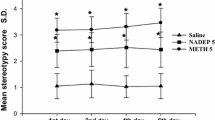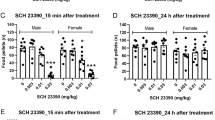Abstract
Mice administered dexamphetamine (4 mg/kg i.p.) once daily for 20 days displayed an enhanced locomotor response (compared to that of vehicletreated mice) to dexamphetamine when challenged 4 to 16 days but not when challenged 32 days after withdrawal.
In the experiments described a 20-day dexamphetamine administration followed by an 8-day withdrawal period was used. Pimozide or haloperidol not only completely antagonised the enhanced response to dexamphetamine (2 mg/kg i.p.) in dexamphetamine-treated mice, but also antagonised all dexamphetamine-induced stimulation. Reserpine, in contrast, preferentially blocked the difference in the response to dexamphetamine of dexamphetamine-and vehicle-treated mice, without antagonising all the dexamphetamine-induced locomotion. The stimulation produced in dexamphetamine-(but not in vehicle-) treated mice by dexamphetamine was partially blocked by phentolamine, phenoxybenzamine, and propranolol. FLA-63 did not significantly influence the response to dexamphetamine in either group. That a dopaminergic mechanism plays a major role in the enhanced response to dexamphetamine was shown by the significantly greater response in dexamphetamine-treated mice to apomorphine challenge.
The treatment of mice with apomorphine (10 mg/kg/day i.p. for 20 days), produced a greater response to apomorphine challenge in the apomorphine-treated mice than in vehicle-treated mice 8 days after withdrawal.
The data show that with long-term administration both dexamphetamine and apomorphine are able to produce in mice what appear to be supersensitive dopamine receptors. Moreover, the enhanced response to dexamphetamine after withdrawal from long-term dexamphetamine treatment appears to require the presence of reserpine-sensitive amine stores and, to a lesser extent, the presence of unblocked α-adrenergic receptors.
Similar content being viewed by others
References
Andén, N.-E.: Pharmacological and anatomical implications of induced abnormal movements with l-Dopa. In: l-Dopa and Parkinsonism, A. Barbeau and F. H. McDowell, eds., pp. 132–143, Philadelphia: Davis 1970
Andén, N.-E., Butcher, S. G., Corrodi, H., Fuxe, K., Ungerstedt, U.: Receptor activity and turnover of dopamine and noradrenaline after neuroleptics. Eur. J. Pharmacol. 11, 303–314 (1970)
Andén, N.-E., Rubenson, A., Fuxe, K., Hökfelt, T.: Evidence for dopamine receptor stimulation by apomorphine. J. Pharm. Pharmacol. 19, 627–629 (1967)
Andén, N.-E., Strömbom, U., Svensson, T. H.: Dopamine and noradrenaline receptor stimulation: reversal of reserpine-induced suppression of motor activity. Psychopharmacologia (Berl.) 29, 289–298 (1973)
Barbeau, A.: l-Dopa therapy in parkinson's disease: a critical review of nine years experience. Can. Med. Assoc. J. 101, 59–68 (1969)
Baudry, M., Martres, M.-P., Schwartz, J.-C.: Modulation in the sensitivity of noradrenergic receptors in the CNS studied by the responsiveness of the cyclic AMP system. Brain Res. 116, 111–124 (1976)
Brodie, B. B., Cho, A. K., Gessa, G. L.: Possible role of p-hydroxynorephedrine in the depletion of norepinephrine induced by d-amphetamine and in tolerance to this drug. In: Amphetamines and related compounds; Proceedings of the Mario Negri Institute for Pharmacological Research, Milan, Italy, E. Costa and S. Garattini, eds., pp. 217–230. New York: Raven Press 1970
Burt, D. R., Creese, I., Snyder, S. H.: Antischizophrenic drugs: chronic treatment elevates dopamine receptor binding in brain. Science 196, 326–328 (1977)
Carlsson, A.: Biochemical implications of Dopa-induced actions on the central nervous system, with particular reference to abnormal movements. In: l-Dopa and Parkinsonism, A. Barbeau and F. H. McDowell, eds., pp. 205–213. Philadelphia: Davis 1970a
Carlsson, A.: Amphetamine and brain catecholamines. In: Amphetamines and related compounds: Proceedings of the Mario Negri Institute for Pharmacological Research. Milan, Italy, E. Costa, and S. Garattini, eds., pp. 289–300. New York: Raven Press 1970b
Carlsson, A.: Dopaminergic autoreceptors. In: Chemical tools in catecholamine research, vol. II, O. Almgren, A. Carlsson, and J. Engel, eds., pp. 219–225. Amsterdam: North-Holland 1975
Carlsson, A., Corrodi, H., Florvall, L., Ross, S.: The Swedish Patent Application 17198/1967 (1967)
Chiel, H., Yehuda, S., Wurtman, R. J.: Development of tolerance in rats to the hypothermic effects of d-amphetamine and apomorphine. Life Sci. 14, 483–488 (1974)
Costentin, J., Protais, P., Schwartz, J.-C.: Rapid and dissociated changes in sensitivities of different dopamine receptors in mouse brain. Nature 257, 405–407 (1975)
Dunstan, R., Jackson, D. M.: The demonstration of a change in adrenergic receptor sensitivity in the central nervous system of mice after withdrawal from long-term treatment with haloperidol. Psychopharmacology 48, 105–114 (1976)
Ellinwood, E. H.: “Accidental conditioning” with chronic meth-amphetamine intoxication: implication for a theory of drug habituation. Psychopharmacologia (Berl.) 21, 131–138 (1971)
Engel, J., Liljeqvist, S., Johannessen, K.: Behavioural effects of long-term treatment with antipsychotic drugs. In: Antipsychotic drugs, pharmacodynamics and pharmacokimetics, Y. Zotterman, B. Uvnäs, and G. Sedvall, eds., pp. 63–71. New York: Pergamon Press 1976
Fjalland, B., Møller-Nielsen, I.: Enhancement of methylphenidateinduced stereotypies by repeated administration of neuroleptics. Psychopharmacologia (Berl.) 34, 105–109 (1974)
Herman, Z. S., Trzeciak, H., Chruściel, T. L., Kmieciak-Kolada, K., Drybański, A., Sokola, A.: The influence of prolonged amphetamine treatment and amphetamine withdrawal on brain biogenic amine content and behaviour in the rat. Psychopharmacologia (Berl.) 21, 74–81 (1971)
Jackson, D. M.: The involvement of noradrenergic systems in the locomotor activity stimulation in mice produced by β-phenylethylamine. J. Pharm. Pharmacol. 26, 651–654 (1974)
Jackson, D. M., Andén, N.-E., Engel, J., Liljeqvist, S.: The effect of long-term penfluridol treatment on the sensitivity of the dopamine receptors in the nucleus accumbens and in the corpus striatum. Psychopharmacologia (Berl.) 45, 151–155 (1975a)
Jackson, D. M., Dunstan, R., Bracs, P. U.: Pharmacological models in tardive dyskinesia: a role for dopamine and noradrenaline? In: Drugs and psychiatry, G. F. S. Johnson, ed., pp. 13–21. Geigy Psychiatric Symposium, Sydney 1975b
Jacobsen, E.: Tranquillisers and sedatives. In: Evaluationof drug activities, pharmacometrics, vol. I, D. R. Laurence and A. L. Bacharach, eds., pp. 215–237. London: Academic Press 1964
Klawans, H. L., Crossett, P., Dana, N.: Effect of chronic amphetamine exposure on stereotyped behaviour: implications for pathogenesis of l-Dopa-induced dyskinesias. In: Advances in neurology, Vol. 9, D. B. Calne, T. N. Chase, and A. Barbeau, eds., pp. 105–112. New York: Raven Press 1975b
Klawans, H. L., Margolin, D. I.: Amphetamine-induced dopaminergic hypersensitivity in guinea pigs. Arch. Gen. Psychiatry 32, 725–732 (1975)
Klawans, H. L., Margolin, D. I., Dana, N., Crossett, D.: Supersensitivity of d-amphetamine and apomorphine-induced stereotyped behaviour induced by chronic d-amphetamine administration. J. Neurol. Sci. 25, 283–289 (1975a)
Klawans, H. L., Rubovits, R.: An experimental model of tardive dyskinesia. J. Neurol. Trans. 33, 235–246 (1972)
Lewander, T.: Urinary excretion and tissue levels of catecholamines during chronic amphetamine intoxication. Psychopharmacologia (Berl.) 13, 394–407 (1968)
Lewander, T.: Effects of acute and chronic amphetamine intoxication on brain catecholamines in the guinea pig. Acta Pharmacol. Toxicol. 29, 209–225 (1971)
Markham, C. H.: The choreoathetoid movement disorder induced by levodopa. Clin. Pharmacol. Ther. 12, 340–346 (1971)
Moore, K. E., Dominic, J. A.: Tyrosine hydroxylase inhibitors. Fed. Proc. 30, 859–870 (1971)
Overstreet, D. H., Kozar, M. D., Lynch, G. S.: Reduced hypothermic effects of cholinomimetic agents following chronic anticholinesterase treatment. Neuropharmacol. 12, 1017–1032 (1973)
Peachy, J. E., Rogers, B., Brien, J. F.: A comparative study of the behavioural responses induced by chronic administration of methamphetamine and amphetamine in mice. Psychopharmacology 51, 137–140 (1977)
Rylander, G.: Psychoses and the punding and choreiform syndromes in addition to central stimulant drugs. Psychiatr. Neurol. Neurochir. 75, 203–213 (1972)
Sahakian, B. J., Robbins, T. W., Iversen, S. D.: α-Flupenthixol induced hyperactivity by chronic dosing in rats. Eur. J. Pharmacol. 37, 169–178 (1976)
Schelkunov, E. L.: Adrenergic effect of chronic administration of neuroleptics. Nature (Lond.) 214, 1210–1212 (1967)
Segal, D. S., Mandell, A. J.: Long-term administration of d-amphetamine: progressive augmentation of motor activity and stereotypy. Pharmacol. Biochem. Behav. 2, 249–255 (1974)
Smith, R. L., Dring, L. G.: Patterns of metabolism of β-phenylisopropylamines in man and other species. In: Amphetamines and related compounds; Proceedings of the Mario Negri Institute for Pharmacological Research, Milan, Italy, E. Costa and S. Garattini, eds., pp. 121–139. New York: Raven Press 1970
Svensson, T. H.: Functional and biochemical effects of d-and l-amphetamine on central catecholamine neurons. Naunyn-Schmiedebergs Arch. Pharmacol. 271, 170–180 (1971a)
Svensson, T. H.: The effect of inhibition of catcholamines in motor activity. M.D. thesis, Göteborgs Universitet (1971b)
Strömbom, U.: Catecholamine receptor agonists: effects on motor activity and rate of tyrosine hydroxylation in mouse brain. Naunyn Schmiedebergs Arch. Pharmacol. 292, 167–176 (1976)
Tarsy, D., Baldessarini, R. J.: Behavioural supersensitivity to apomorphine following chronic treatment with drugs which interfere with the synaptic function of catecholamines. Neuropharmacology 13, 927–940 (1974)
Ungerstedt, U.: Postsynaptic supersensitivity after 6-OH-dopamine induced degeneration of the nigro-striatal dopamine system. Acta Physiol. Scand. [Suppl.] 367, 69–93 (1971)
Weissman, A., Koe, B. K., Tenen, S. S.: Antiamphetamine effects following inhibition of tyrosine hydroxylase. J. Pharmacol. Exp. Ther. 151, 339–352 (1966)
Author information
Authors and Affiliations
Rights and permissions
About this article
Cite this article
Bailey, R.C., Jackson, D.M. A pharmacological study of changes in central nervous system receptor responsiveness after long-term dexamphetamine and apomorphine administration. Psychopharmacology 56, 317–326 (1978). https://doi.org/10.1007/BF00432856
Received:
Issue Date:
DOI: https://doi.org/10.1007/BF00432856




